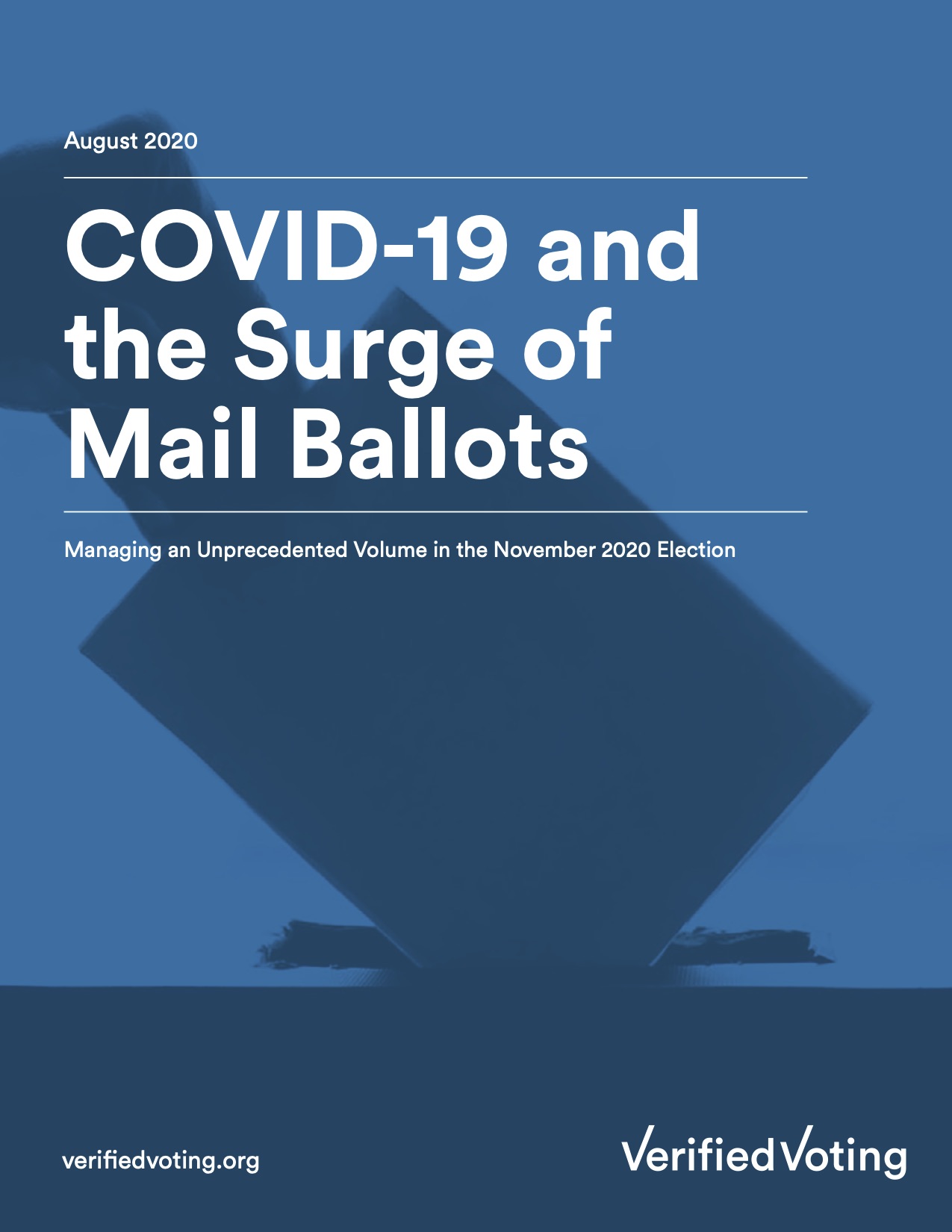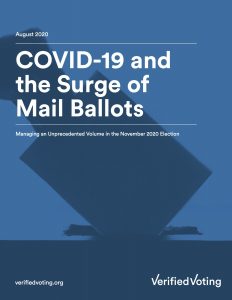
report
COVID-19 and the Surge of Mail Ballots: Managing an Unprecedented Volume in the November 2020 Election
Date: August 3, 2020
Author: Verified Voting
Issue: Voting Equipment, Paper Records
Publication Summary
Jurisdictions across the country have seen a significant increase in mail voting during their 2020 primary elections due to the COVID-19 pandemic.
In response to the coronavirus pandemic, election administrators across the country are taking steps to expand mail ballot options for the November general election. Even without the passage of new federal or state mandates for all mail ballot or no excuse absentee voting, jurisdictions have seen and will likely continue to see a significant increase in the number of mail ballots they are required to process. This has led to concern regarding the potential need for high capacity “batch-fed” scanners (traditionally referred to as “central count” scanners) to handle the anticipated increased volume of mail ballots.
Currently, more than three quarters of jurisdictions in the United States tabulate mail ballots using hand-fed scanners (traditionally referred to as “precinct count” scanners) or by hand counting. The remaining jurisdictions already have batch-fed scanners and are therefore more prepared to handle a significant increase in mail ballots. Batch-fed scanners are primarily purchased by larger jurisdictions, so while 77% of jurisdictions count mail ballots with hand-fed scanners or by hand, those jurisdictions represent only 22% of registered voters. By contrast, the approximately 23% of jurisdictions using batch-fed scanners to count mail ballots represent approximately 79% of registered voters.
Using data from the Election Administration and Voting Survey (EAVS), we determined the largest volume of mail ballots processed by a single jurisdiction in the last presidential general election (2016) counted using hand-fed scanners or by hand to establish a high-end benchmark volume for mail ballots that have been processed without the use of batch-fed scanners. We then used this benchmark to identify the jurisdictions that may exceed that benchmark in the event of a significant increase in volume of mail ballots in November 2020.
Methodology
To determine the number of jurisdictions using hand-fed scanners or hand counting mail ballots that may face an unprecedented volume of mail ballots for this technology in the 2020 general election, we
- Leveraged our Verifier database to determine the absentee ballot tabulation equipment currently in use in each jurisdiction.
- Categorized jurisdictions by method used to process mail ballots (batch-fed scanners, hand-fed scanners or hand count).
- Reviewed the volume of mail ballots each jurisdiction processed using hand-fed scanners or by hand in the 2016 general election to determine a high-end benchmark volume of mail ballots processed without batch-fed scanners.
- Reviewed the total voter turnout from each jurisdiction in the 2016 presidential election to establish a hypothetical maximum volume of mail ballots for the 2020 presidential election.
- Determined the number of jurisdictions currently counting mail ballots with hand-fed scanners or by hand that would be in the position of processing more than the 2016 high-end benchmark volume of mail ballots if they were required to handle a volume of mail ballots equal to 100% of their total 2016 turnout.
Results and Discussion
Approximately 21% of all precincts in the United States count their absentee ballots using hand-fed scanners, approximately 2% count mail ballots by hand and approximately 77% use batch-fed scanners. During the 2016 presidential election, the jurisdictions that counted mail ballots using hand-fed scanners or by hand count processed an average of 524 ballots, with 1 being the smallest number and 21,939 the maximum. Eleven of these jurisdictions counted more than 10,000 mail ballots on hand-fed scanners. Verified Voting spoke with a sampling of election officials who processed 10,000 or more ballots on hand-fed scanners and they noted that it was manageable owing to their particular structures, which include housing several hand-fed scanners in their offices and beginning to count absentee ballots early, when possible.
If the jurisdictions currently counting mail ballots on hand-fed scanners or by hand were required to handle the equivalent of 100% of their 2016 voter turnout by mail in the 2020 presidential election, approximately 17% of these jurisdictions would be required to count more than 10,000 mail ballots on hand-fed scanners or by hand, while approximately 6% would be above the 21,939 high-end benchmark. Compared to all jurisdictions, including those counting mail ballots on batch-fed scanners, about 13% of jurisdictions would have to count more than 10,000 mail ballots on hand-fed scanners or by hand and only 5% would be over the 21,939 high-end benchmark.
Conclusion
From our estimates, only approximately 5% of all jurisdictions in the United States would need to count more than the 2016 high-end mail ballot benchmark of 21,939 ballots using hand-fed scanners or counting by hand if they were required to handle a volume of mail ballots equal to 100% of their 2016 total voter turnout.
Because most jurisdictions will not be moving to all mail ballot voting systems for the 2020 general election, it is likely that most could manage the increase of mail ballots for one election using their current equipment if they have the additional staff, extended canvassing time, and ability to reallocate hand-fed scanners to process the ballots. Even jurisdictions that currently use batch-fed scanners to count mail ballots, like Philadelphia, should consider lessons learned from their primaries about scanning capacity, staffing needs, and canvassing timelines as they anticipate mail ballot volume ahead of November.
Election officials across the country are aware of the likely increase in mail ballots and are already putting appropriate plans into place. As limited resources are starting to be allocated, it is important to understand whether or not it will be necessary for new tabulation equipment to be purchased or leased and where this may occur, especially given the short time frame and limited resources available to prepare for the general election.
Mail Ballot Tabulation Systems
| Make | Model | States | Jurisdictions | % Jurisdictions | Precincts | % Precincts | Registered Voters | % Registered Voters |
| Hand-Fed Optical Scanners | ||||||||
| Clear Ballot | ClearCast | 1 | 59 | 0.93% | 105 | 0.06% | 101,918 | 0.05% |
| Dominion | ImageCast Precinct | 6 | 238 | 3.73% | 2,306 | 1.29% | 3,929,620 | 1.85% |
| Dominion | ImageCast Evolution | 4 | 312 | 4.90% | 1,361 | 0.76% | 1,311,674 | 0.62% |
| Diebold (Dominion) | AccuVote OS | 11 | 646 | 10.14% | 5,038 | 2.83% | 7,533,296 | 3.55% |
| Sequoia (Dominion) | Optech Insight | 2 | 141 | 2.21% | 216 | 0.12% | 210,220 | 0.10% |
| ES&S | DS200 | 32 | 1,587 | 24.90% | 18,324 | 10.29% | 19,264,976 | 9.08% |
| ES&S | Model 100 | 15 | 226 | 3.55% | 3,239 | 1.82% | 2,249,582 | 1.06% |
| Hart | eScan | 5 | 148 | 2.32% | 3,580 | 2.01% | 3,498,260 | 1.65% |
| Hart | Verity Scan | 5 | 58 | 0.91% | 1,055 | 0.59% | 1,932,915 | 0.91% |
| Unisyn | OpenElect OVO | 7 | 172 | 2.70% | 2,735 | 1.54% | 3,569,138 | 1.68% |
| Subtotal Hand-Fed Scanners | 35 | 3,587 | 56.28% | 37,959 | 21.31% | 43,601,599 | 20.55% | |
| Batch-Fed Optical Scanners | ||||||||
| Clear Ballot | ClearCount | 6 | 75 | 1.18% | 17,200 | 9.66% | 15,490,052 | 7.30% |
| Dominion | ImageCast Central | 19 | 496 | 7.78% | 45,005 | 25.27% | 50,912,156 | 24.00% |
| Diebold (Dominion) | AccuVote OS Central | 5 | 5 | 0.08% | 2,544 | 1.43% | 2,223,663 | 1.05% |
| Dominion (Sequoia) | NCS OpScan 5 | 2 | 2 | 0.03% | 1,214 | 0.68% | 860,226 | 0.41% |
| ES&S | DS450 | 25 | 226 | 3.55% | 10,042 | 5.64% | 12,119,699 | 5.71% |
| ES&S | DS850 | 34 | 256 | 4.02% | 33,563 | 18.85% | 49,400,719 | 23.29% |
| ES&S | Model 650 | 12 | 86 | 1.35% | 3,013 | 1.69% | 2,976,361 | 1.40% |
| Hart | Ballot Now | 7 | 99 | 1.55% | 4,351 | 2.44% | 6,546,351 | 3.09% |
| Hart | Verity Central | 15 | 99 | 1.55% | 10,974 | 6.16% | 14,878,916 | 7.01% |
| MicoVote | MicroVote/ Chatsworth | 2 | 88 | 1.38% | 3,279 | 1.84% | 3,282,776 | 1.55% |
| Smartmatic | VSAP Tally | 1 | 1 | 0.02% | 4,164 | 2.34% | 6,858,459 | 3.23% |
| Unisyn | OpenElect OVCS | 11 | 64 | 1.00% | 2,681 | 1.51% | 2,795,270 | 1.32% |
| Subtotal Batch-Fed Optical Scanners | 46 | 1,497 | 23.49% | 138,030 | 77.51% | 168,344,648 | 79.35% | |
| Hand Count | 16 | 1,291 | 20.26% | 3,231 | 1.81% | 1,951,208 | 0.92% | |
| Hand-Fed Scanners + Hand Count | 16 | 4,878 | 76.54% | 41,190 | 23.13% | 45,552,807 | 21.47% | |
| Optical Scanners + Hand Count | 51 | 6,375 | 100.03% | 179,220 | 100.64% | 213,897,455 | 100.82% | |
Table current as of July 30, 2020
Additional Resources
Vote at Home: 2020 Mail Ballot Use So Far
Ballotpedia: Changes to absentee/mail-in voting procedures in response to the coronavirus (COVID-19) pandemic, 2020
Washington Post: At least 76% of American voters can cast ballots by mail in the fall
